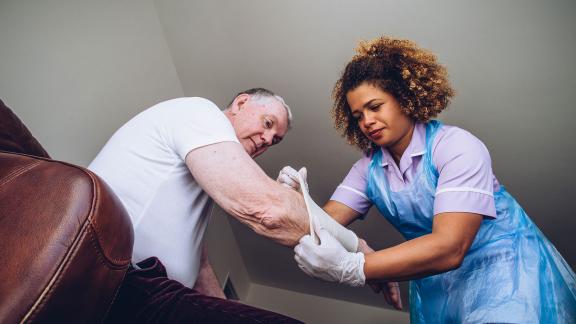More ringfenced investment will be required to empower community services

The March Budget is an opportunity to support community services through targeted investment, explain Daniel Reynolds, of the NHS Confederation, and Miriam Deakin, of NHS Providers.
We are still in the eye of the COVID-19 storm, with all parts of the health and care system under extreme pressure. There are now more patients in hospital with COVID-19 than at the time of the April peak. And if it wasn’t for the vital work of services in the community, many of our hospitals would have been overwhelmed by now.
Community services continue to play an essential role in getting the country through the pandemic, with 15 per cent more patients being treated in the community compared to last year. A key weapon in our armoury is boosting efforts to enable the safe and rapid discharge of medically fit people into appropriate settings and caring for people in or near their homes. New policy announcements made this week, will aid these efforts.
But we know it will not be enough as community services continue to come under unprecedented strain; managing COVID-19 and non-COVID-19 care, providing essential support to care homes, responding to the usual increase in seasonal illness, and since December, playing a leading role in the COVID-19 vaccine delivery programme. More ringfenced investment will be required if we are to sustain and empower community services.
While community providers faced considerable pre-pandemic pressures, this next period will see a significant rise in demand for community services
In a letter to system leaders this week, NHS England and NHS Improvement’s director of community health outlined a range of supportive measures. These included details of how hotel beds can be used for the care of COVID-19 patients who are ready for discharge, and a new national framework to use independent sector capacity for home care if appropriate and available locally. Finally, it also extended indemnity cover for those areas that have not yet got designated COVID-19 care home premises, or for those areas wishing to expand existing premises.
Delayed discharges are creating many challenges for trusts, and these measures will help to find much-needed extra capacity for rapid discharges at a time when hospitals are caring for three quarters more inpatients now than during the April peak. They also come with the necessary local flexibility to allow leaders to do what’s best for their communities.
However, this package of measures will not solve long-term issues of under-investment in community services. The Community Network – which is hosted by the NHS Confederation and NHS Providers – has this week urged the government to invest in community services in the March Budget to further support the national effort to combat coronavirus.
While community providers faced considerable pre-pandemic pressures, this next period will see a significant rise in demand for community services. This will be driven by the need to provide care for people living with the long-term effects of COVID-19, looking after more people with complex needs at discharge, and a backlog of care from the first wave of the pandemic when some services had to be put on hold. On top of that, community services are also playing a key role in the roll out of the vaccine.
Given community providers are looking after increasing numbers of COVID-19 patients in recovery, more funding will clearly be required to meet the ongoing costs of treatment
That’s why extra investment and support for community services will be vital. Much of the welcome extra investment for the NHS during the pandemic has been targeted at other parts of the system, including new capital funding which has largely not made its way to community services. Given community providers are looking after increasing numbers of COVID-19 patients in recovery, more funding will clearly be required to meet the ongoing costs of treatment.
The March Budget is therefore an opportunity for more targeted investment in community services, including emergency funding now and for the next financial year to continue supporting the discharge to assess model. These are innovative ways of discharging patients, which have been invaluable in helping medically fit patients to leave hospital faster.
Of course, the NHS does not exist in a vacuum and we are dependent on the social care system and public health infrastructure, which are both struggling under the weight of the pandemic after years of disinvestment. We are therefore also calling for the government to clarify when it will address its commitment to reform social care, and how it will ensure in the short-term that local authorities have sufficient funding to fix historical cuts to public health and community health contracts.
In the longer term, there will need to be a reprioritisation of the “ask” of community health providers and their teams which matches rising demand for care and the need to move more services closer to people’s homes. The pandemic has demonstrated – all too painfully – how important this is.
Daniel Reynolds is Director of Communications at the NHS Confederation. Miriam Deakin is director of policy and strategy at NHS Providers. Follow them on Twitter @DanielReynolds4 @MiriamDeakin
This feature was first published by the HSJ.



